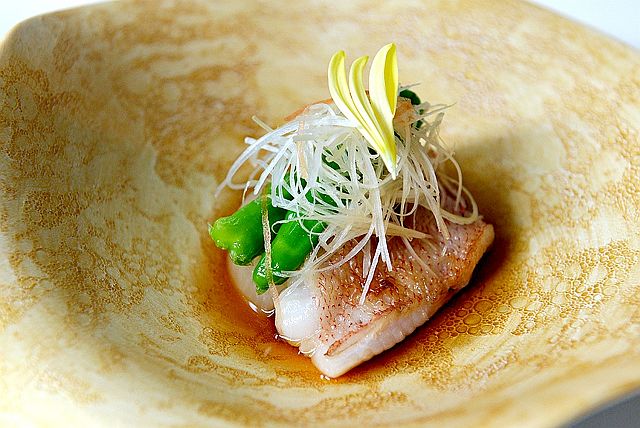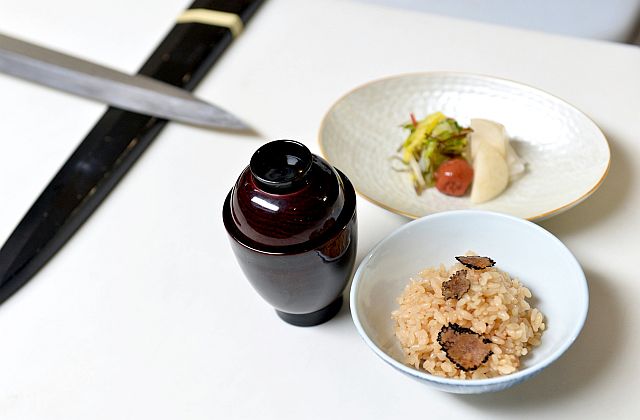
Stewed Japanese Wagyu Beef and Yuba Soy Skin
JAPANESE billionaire Kazuo Okada’s biggest project, Okada Manila, the Philippines’ newest and largest integrated resort and soon to be one of the world’s largest casino complexes, occupies 44 hectares of the booming Entertainment City in Parañaque. With over 21 diverse dining options, Okada Manila offers a taste of the world’s flavors. At the forefront is Kappou Imamura, an upscale contemporary Japanese restaurant that is scheduled to open soon located at the upper ground level of Okada Manila close to the gaming area with a spectacular view of Manila Bay.
The restaurant is named after its young and artistic 38-year-old Japanese chef, Hirofumi Imamura, whose culinary brilliance has earned for Kasuo Okada’s restaurant in Kowloon, Hongkong, a Michelin Star. He hails from the city of Fukuoka where he started his culinary career in 1997 as an apprentice. His passion for the culinary arts fired his desire to train and excel in sushi and kaiseki preparations. Kaiseki is sophisticated Japanese cuisine pretty much similar to the French Haute Cuisine.
I was one of the lucky ones who were privileged to experience the culinary wonders of Chef Imamura that defines the world-class authentic Japanese
cuisine of Okada’s Kappou Imamura. The invitation for the signature six-course Tasting Menu was held at Anzani Prime above The Tinderbox along Gov. Cuenco Avenue. The Okada pre-opening team came in full force, led by its President, Steve Wolstenholme.

Yaki-Nituke Style Charcoal Grilled Kinki Fish
Chef Imamura’s “Philosophy of Five”, the traditional culinary tradition using five senses: five colors (green, red, black, yellow, white), five tastes, five ways and five attitudes was reflected on his exquisite, artistic creations, I will learn as the evening progressed that he does not use any of the modern
gastronomy techniques. The opener was truly dramatic, Flash-Smoked
Seasonal Fish Salad—a seared rosy sea bass and rolled scallions and julienned vegetables in miso vinegar paired with a glass of Spy Valley Echelon Method Tradionale. Together, we carefully lifted the soft paper cover, releasing the smoke trapped in the glass container as Chef Imamura did his rounds on all the tables, explaining the dish.
There was, indeed, a subtle smoky flavor. Saki-Simmered Lobster in Thick Winter Sauce with lily bulb and lotus in thick taro sauce was served next. The winter sauce, Chef explained is made from winter vegetables from Japan like mustard and spinach. It is essential that his ingredients are always fresh so he is also looking into the local produce available. He serves sauces Ginza-style, which means adjusted to the taste of the customer.
The Yaki-Nituke Style Grilled Kinki Fish with stewed daikon radish, shishito pepper and Japanese leek was served with Dog Point Chardonnay, New Zealand. The kinki fish or snapper is famously called “thorny head fish” and is highly seasonal in Japan. Shishito peppers are finger-sized sweet East Asian variety of capsicum.

Truffle Rice and Miso Soup
I love these shishito peppers simply grilled and dipped in ponzu sauce. After the light seafood dishes, we welcomed the Stewed Japanese Wagyu Beef in soy and Yuba Soy Skin with arrowhead, Napa and Japanese carrot in egg foam. Here I get familiar with yuba soy skin, an esteemed epicurean ingredient that is actually a thin film that forms on surface of soymilk as cream and protein rise to surface. His egg foam was beaten manually. We washed down the tender, succulent wagyu with Resalte Gran Reserve 2009.
The last dish was Truffle Rice and Miso Soup. The dessert left me breathless: Yuzu Gianduja with Bitter Chocolate Mouse & Mango Sorbet. I ended the exquisite meal with a better understanding of the Philosophy of Five!
